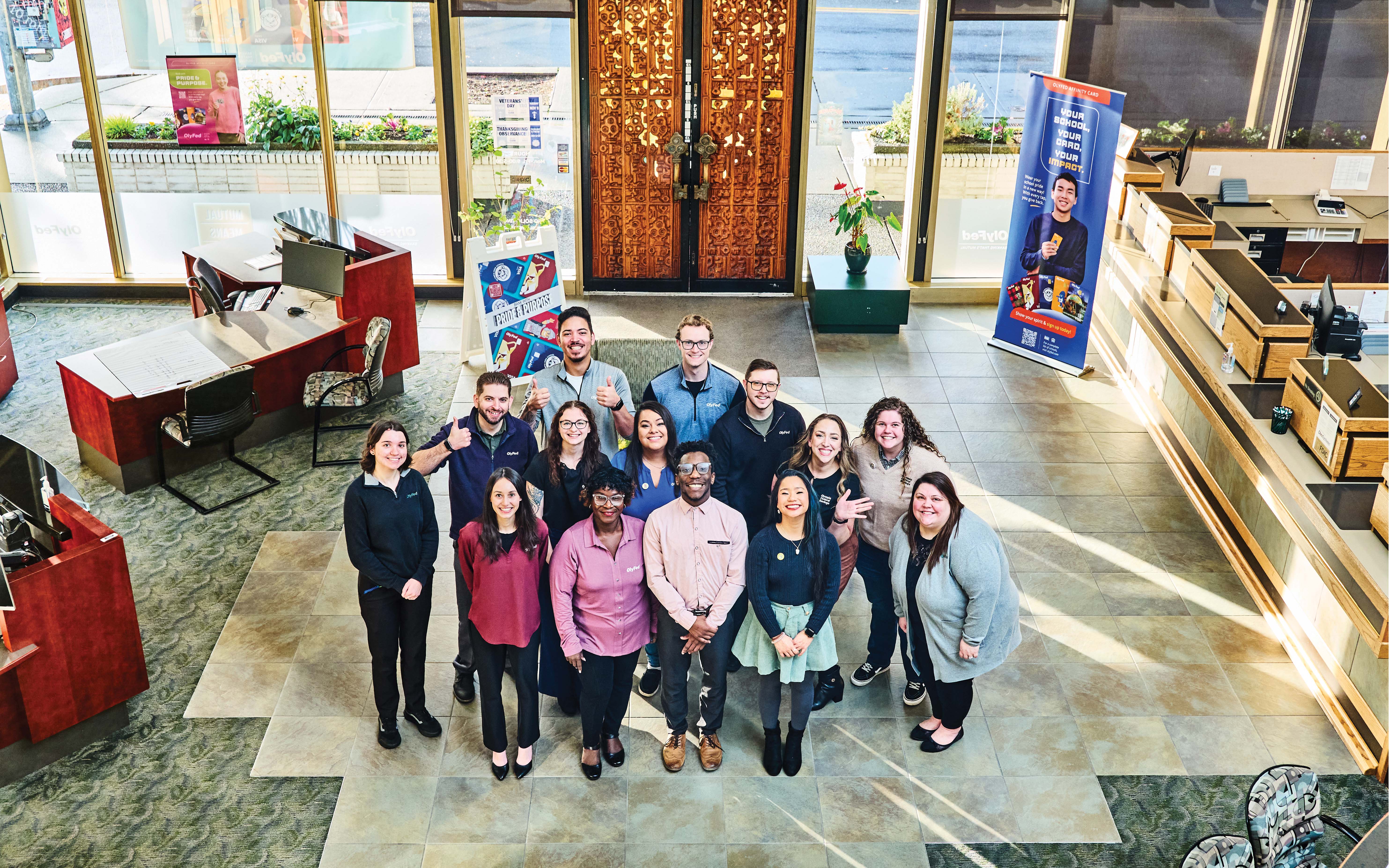Community banking requires vigor, skill and passion to withstand the test of time. That’s why ICBA is honoring member banks celebrating 100, 125, 150, 175 and even 200 years in service. Read on for stories of how these community banks started out, persevered and have made a difference in their communities.
Member Milestones 2025: Community Banks Are Here to Stay
August 01, 2025 / By Roshan McArthur
Community banking requires vigor, skill and passion to withstand the test of time. That’s why ICBA is honoring member banks celebrating 100, 125, 150, 175 and even 200 years in service. Read on for stories of how these community banks started out, persevered and have made a difference in their communities.
Imagine, if you can, the United States of America in the year 1825. The Declaration of Independence is only 49 years old, the Civil War is 36 years from starting, there are 24 states in the union and our sixth president, John Quincy Adams, has just begun his term.
The country is in the throes of the Industrial Revolution, and the Erie Canal has finally been completed after eight years of hard labor, using teams of oxen. At 363 miles in length, it connects the Great Lakes with the Atlantic, allowing goods to be transported at a tenth of the cost and in half the time.
In Millbury, Massachusetts, Asa Waters II is running the Waters & Co. Armory out of a small mill in the Blackstone Valley. This gun business is thriving, with the U.S. government among Waters’ customers, and he decides that his thriving community needs a bank. That’s when 73 local business owners come together and Millbury Bank is born.
Two hundred years later, the number of these United States has more than doubled, we’ve elected our 47th president and the canal that revolutionized commerce is mostly used for recreation. But Asa Waters’ bank, which now has $133 million in assets, is standing strong. Along the way, it survived an attempted takeover by New York capitalists in 1852 and weathered the turmoil of the Great Depression, two World Wars and a global pandemic.
Read on to learn how Millbury Bank, along with some of the 54 other community banks that celebrate milestone anniversaries this year, have survived and thrived for a century or more.
200 years in service
Millbury National Bank
Location:
Millbury, Massachusetts
Assets:
$133 million
Ranking as either the fifth- or sixth-oldest bank in the country is a massive feat for the organization now known as Millbury National Bank (MNB).
Kate Marcum, CEO and chairman of the board, laughs as she explains the uncertainty. “There’s another bank that’s 200 at the beginning of June,” she says. “June is also our anniversary, but we don’t know the exact date.”
The details may be fuzzy, but there’s no doubting the community bank’s staying power, which Marcum attributes to three key factors. “We really focus on risk management and culture,” she says. “We have multigenerational employees, stockholders and board members, and we really work on management succession.”
In short, when it comes to MNB, people stick around. Marcum herself is third generation; her grandfather and then father served as presidents from 1939 to 1995 before she became president in 2002. The average employee tenure is more than 10 years, while the average officer tenure is over 20.
John Latino, president and COO, says MNB may seem “risk averse” compared with other—often bigger—banks, but there’s a reason for that.
“We stay focused on what we’re here for, which is to serve the community,” he explains. “So, when we’re making decisions on how to operate the bank and we’re evaluating risk, we’re never going to bet the bank on something that doesn’t support our long‑term goal.”
That doesn’t mean the community bank is afraid to be creative. In fact, creativity is one of its core values. “When you’re a one-branch bank, and you’re the size that we are, with the mission that we have, we have to act different than everyone else,” says Latino. “During the pandemic, we found ways to be flexible and creative and take care of our customers.”
Whether it was figuring out how to close a home equity line of credit in the drive-thru or how to educate two 85-year-olds on mobile check deposit and online account opening, Latino says staff figured it out. “And we did it with what has always made us different, which is that creativity, that high personal touch,” he adds.
Two hundred years is a milestone that’s worth celebrating. “And oh boy, are we celebrating,” laughs Sue Nydam, executive vice president, CFO and Marcum’s sister. “We’ve got events every quarter. It’s everything from random acts of kindness in the community where we buy gas for people or groceries, to Earth Day, when we had plants for all of our customers.”
The celebrations reached their peak in June, with events every week and a gala for 350 guests at the mansion of the bank’s founder, Asa Waters, a popular local landmark that was rescued from ruin in 1995.
“It’s amazing to think how much has changed in the last 20 years, never mind the last 200,” says John Latino. Looking two centuries into the future, he says, “I hope the bank is still independent and serving this community. I don’t know if at that point we’ll be financing hovercrafts and space mobiles! Whatever it is, we’ll hopefully be doing it.”
Sticking to their guns
When you walk into Millbury National Bank in Massachusetts, you may be surprised to see a collection of firearms on display. It’s an unusual sight but, given the 200-year-old bank’s history, perhaps not all that surprising.
“The bank was founded by a man named Asa Waters,” explains CEO Kate Marcum. “He owned a gun factory. From what we understand, he could not get a loan. He started this bank so he’d have a place to finance his gun factory.”
If you come into the bank, you’ll see the guns on display, says Marcum. “It kind of puts people off,” she laughs. “But we don’t have any ammunition. We just have the guns, and we also don’t know how to use them!”
“We get a lot of comments about our building,” adds John Latino, president of Millbury National Bank. “It’s old, and [maintaining] it [can give] us some headaches sometimes, but it’s really a beautiful building. Customers like seeing some of the old infrastructure of the bank, like our vault. It is actually in the lobby, so you can kind of see it through the gates. Sometimes the kids like to go and climb on the vault door.
“As Kate likes to say, when you come into our bank, it feels welcoming, not like a Taj Mahal or an echo chamber, like some of these other large institutions,” he adds. “No matter what the future brings … I hope we still have the building!”
150 years in service
FNB Bank, Inc.
Location:
Mayfield, Kentucky
Assets:
$718 million
The year is 1875. The Civil War has been over for 10 years, and the notorious outlaw Billy the Kid is arrested—for the first time—after stealing a basket of laundry. The Wild West is truly wild, with countless Americans heading west in search of a new start.
It’s during this time of cowboys, outlaws and pioneers that First National Bank of Mayfield is established by Major Henry S. Hale, right in the heart of the Jackson Purchase in Kentucky.
A century and a half later, Mayfield’s FNB Bank, Inc. is still thriving. Kentucky’s seventh-oldest bank has 10 offices in five counties across western Kentucky and $718 million in assets. But it hasn’t been an easy journey.
The bank’s original building, which dominated Mayfield’s Court Square, was remodeled in 1921 but burned to the ground in 1936. That location was rebuilt by the next year, but in 2008, FNB broke ground on a new headquarters next door.
Then, in December 2021, this new location was destroyed by a tornado, meaning FNB Bank had to build yet another headquarters. The main office reopened in January 2024 on the same plot of land where it all began back in 1875.
“Celebrating 150 years as a community bank in western Kentucky is an incredible milestone for [us],” says Brooke Wiles, VP and chief marketing officer. “It’s a testament to our deep roots, loyal customers and resilient spirit. Since the devastating tornado, our team has shown incredible strength and dedication [to rebuilding] not just our facilities but also reinforcing our commitment to the communities we serve.”
In honor of its legacy, FNB is celebrating all year long with customer appreciation events and giveaways across all five of its markets—a way of saying “thank you” for 150 years of trust and support, says Wiles.
FNB Bank: After the storm
On December 10, 2021, an EF4 tornado tore through Mayfield, Kentucky, causing catastrophic damage to FNB Bank’s Mayfield main and operations buildings. The tornado’s devastation wasn’t kept to the bank: 24 residents of Mayfield-Graves County were killed and thousands of structures were destroyed.
A year later, FNB Bank marked the anniversary of the tornado by holding a groundbreaking at 101 East Broadway to commemorate the beginning of the reconstruction of its buildings. In January 2024, the new main office building opened for business, and in December, the operations center was completed—just in time to mark the celebration of the community bank’s 150th anniversary.
150 years in service
The Peoples State Bank of Newton
Location:
Newton, Illinois
Assets:
$700 million
Just as First National Bank of Mayfield was being founded, a group of investors in Newton, Illinois, broke ground on the People’s Bank. Today, The Peoples State Bank of Newton has expanded to seven branches and boasts $700 million in assets.
The community bank attributes its longevity to the dedication of its employees and the loyalty of its stockholders and customers. Staying stable in times of uncertainty, from the Great Depression to the recent pandemic, has been possible by staying focused on local needs and building strong relationships, bank leaders say.
In May, The Peoples State Bank of Newton celebrated its 150th anniversary with a weekend full of community spirit, including a special dinner for valued stockholders and employees. In addition, as a way of saying “thank you” to the communities it has served, the community bank welcomed the public to a large celebration at the Jasper County Fairgrounds to enjoy live bands, food trucks and refreshments.
125 years in service
The Farmers State Bank
Location:
Holton, Kansas
Assets:
$76 million
Fast forward to the turn of the 20th century. It’s the year 1900, and The Farmers State Bank of Circleville, Kansas, is chartered with $5,000 in capital. Over the years, the little bank has survived a robbery (1923), the Circleville fire (1931) and a further attempt to break into its vault (1979). But it has also thrived, outgrowing its original location in Circleville. It is now based in Holton and has $76 million in assets.
“The loyal and supportive community that we have, along with the steadfast employees over the years, have attributed to our longevity,” says Tonya Barta, bank president and CEO. “Our slogan of ‘Hometown Banking with Your Neighbors and Friends’ rings true.” The Farmers State Bank, keeping to its hometown style, is marking 125 years with a barbecue, among other commemorative events, in October.
As for what the future holds, “We keep serving our community,” Barta says. “That is the most important thing that we can do, since that is what keeps small communities thriving!”
100 years in service
Connect Community Bank
Location:
Raymond, Washington
Assets:
$70 million
The year is 1925, and Claude House of Raymond, Washington, is working in land improvement and decides his community needs a savings and loan association. After months of rallying other businesspeople, he calls a meeting at Walter’s Café on a Friday in late November 1925, and Pacific Savings and Loan Association is born.
One hundred years and multiple name changes later, the bank is now $70 million-asset Connect Community Bank, with three branches throughout Pacific County. The bank attributes its longevity to maintaining a traditional mutual banking portfolio lending model.
“We are one of a minuscule number of banks left in the country that do not sell our loans to the secondary market,” explains B. Nichoel Casey, president and CEO, speaking on behalf of the bank’s board. “This has allowed us to be conservative when managing risk but remain connected to our members with hands-on, face‑to‑face lending options.
“Like ‘It’s a Wonderful Life,’ we know our customers and can be nimble when needed, as opposed to many other financial institutions,” she adds. “One example: When the local timber mill went on strike a couple of years ago, we were able to craft custom loan modifications within days of the strike to allow members employed there to defer their payments for 90 days.”
To celebrate its centennial, Connect Community Bank is expanding its annual party at the end of November to include bank customers of 20 years.
The board will continue to support the community in the way it always has. “While our mission is to preserve our traditional business model, doing so is no easy task,” says Casey. “To keep an independent loan portfolio requires member investments through deposits, and competition in that space from Wall Street is fierce. We have to educate our community and, hopefully, the industry on the value of traditional lending and the commitment it requires.”
Member Milestones: The past that shapes the future
Explore technology and trends that influenced culture during our member banks’ founding years.
Banking Since 1825
Millbury National Bank, Millbury, Massachusetts
Banking Since 1850
Emigrant Bank, New York City
Banking Since 1875
First National Bank of Bellevue, Bellevue, Ohio
Carrollton Federal Bank, Carrollton, Kentucky
Guilford Savings Bank (GSB), Guilford, Connecticut
The Havana National Bank, Havana, Illinois
FNB Bank, Inc., Mayfield, Kentucky
The Peoples State Bank of Newton, Newton, Illinois
The American National Bank of Texas, Terrell, Texas
The First National Bank in Trinidad, Trinidad, Colorado
Merchants Bank, N.A., Winona, Minnesota
Banking Since 1900
Vision Bank, Ada, Oklahoma
The First National Bank of Assumption, Assumption, Illinois
Banner Banks, Birnamwood, Wisconsin
Success Bank, Bloomfield, Iowa
Cleo State Bank, Cleo Springs, Oklahoma
City National Bank, Colorado City, Texas
First State Bank of Randolph County, Cuthbert, Georgia
Citizens State Bank & Trust Company, Ellsworth, Kansas
Merchants & Farmers Bank of Greene County, Eutaw, Alabama
Stock Growers Bank, Forman, North Dakota
Bank of Colorado, Fort Collins, Colorado
The Jefferson Bank, Greenville, Mississippi
The Farmers State Bank, Holton, Kansas
Skyline National Bank, Independence, Virginia
State Bank of Jeffers, Jeffers, Minnesota
The Killbuck Savings Bank Company, Killbuck, Ohio
First Choice Bank, Pontotoc, Mississippi
Farmers Bank and Trust Company, Marion, Kentucky
First State Bank of Ransom, KS, Ransom, Kansas
Sainte Marie State Bank, Sainte Marie, Illinois
JCBank, Seymour, Indiana
The City National Bank of Taylor, Taylor, Texas
The Maries County Bank, Vienna, Missouri
MCNB Bank and Trust Co., Welch, West Virginia
Banking Since 1925
Citizens State Bank, Buffalo, Texas
Security First Bank of North Dakota, New Salem, North Dakota
Armstrong County Building and Loan Association, Ford City, Pennsylvania
Pendleton Community Bank, Franklin, West Virginia
Grinnell State Bank, Grinnell, Iowa
Prime Security Bank, Karlstad, Minnesota
State Bank & Trust of Kenmare, Kenmare, North Dakota
Dart Bank, Mason, Michigan
The First National Bank of Mount Dora, Mount Dora, Florida
Sunrise Bank Dakota, Onida, South Dakota
Patterson State Bank, Patterson, Louisiana
Peoples State Bank of Plainview, Plainview, Minnesota
Connect Community Bank, Raymond, Washington
The Peoples Bank, Ripley, Mississippi
Savannah Bank, N.A., Savannah, New York
Citizens State Bank, Somerville, Texas
Connect Bank, Star City, Arkansas
Slovenian Savings and Loan Association of Canonsburg, Strabane, Pennsylvania
Commercial State Bank, Wausa, Nebraska
Farmers Bank of Willards, Willards, Maryland
Subscribe now
Sign up for the Independent Banker newsletter to receive twice-monthly emails about new issues and must-read content you might have missed.
Sponsored Content
Featured Webinars
Join ICBA Community
Interested in discussing this and other topics? Network with and learn from your peers with the app designed for community bankers.
Subscribe Today
Sign up for Independent Banker eNews to receive twice-monthly emails that alert you when a new issue drops and highlight must-read content you might have missed.
News Watch Today

Join the Conversation with ICBA Community
ICBA Community is an online platform led by community bankers to foster connections, collaborations, and discussions on industry news, best practices, and regulations, while promoting networking, mentorship, and member feedback to guide future initiatives.













